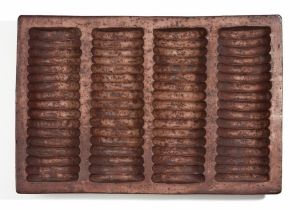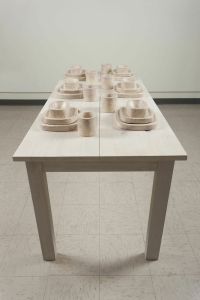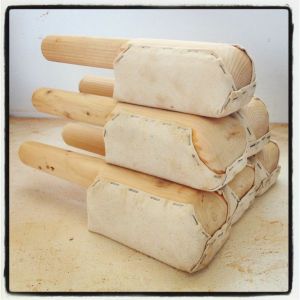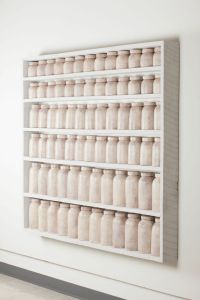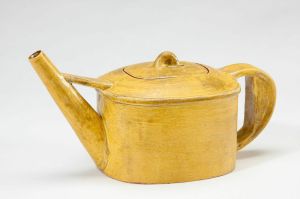The 2015 Potter of the Month series kicks off with a potter whose pots pepper my kitchen cupboards: Joseph Pintz. Joe and I met at the  Archie Bray Foundation in 2006 and became fast friends. I’ve always admired Joe’s work and his work ethic. His pots are timeless. He pairs no-nonsense forms with rich patinas that speak of history and use. What results are handsome, thoughtful, generous pieces that beg to be used.
Archie Bray Foundation in 2006 and became fast friends. I’ve always admired Joe’s work and his work ethic. His pots are timeless. He pairs no-nonsense forms with rich patinas that speak of history and use. What results are handsome, thoughtful, generous pieces that beg to be used.
In the interview, Joe discusses how his background in anthropology helped shape his perspective of what it means to be a potter, how he balances a full-time teaching job with an active studio practice and where he looks for inspiration for new forms. Enjoy!
How did you first get involved in ceramics? Can you briefly describe your background and education? I took my first ceramics class at a local community art center while I was studying anthropology at Northwestern University. At first, ceramics was just a hobby but my interest continued to grow over the years. I decided to go back to school to learn more and was a post-bacc at Southern Illinois University- Edwardsville. At the same time, I was lucky enough to work with Dan Anderson as his studio assistant. I went on to earn my MFA at the University of Nebraska, while working with Gail Kendall, Pete Pinnell and Eddie Dominguez.
How does your background in anthropology influence the type of work you make (forms/surfaces/etc)? I think my background in anthropology not only influences my work but how I look at the world around me. Through my study of anthropology, I learned how material culture functions within a society. I find it fascinating that much of what is known about early cultures comes purely from the archaeological record. Even a humble shard of ceramics can reveal a wealth of information about traditions, values, and beliefs.
For thousands of years, the role of art was to communicate or comment on culture. Art was not separate from daily life; it was a central part of it. The work of anthropologist Ellen Dissanayake focuses on this link between art and culture. She redefined art within a cultural context as ‘making special’; art takes everyday experience and elevates it out of the mundane. As a potter, I strive to achieve this age-old goal in my own work.
How do you feel that your formal education (undergraduate/graduate school) prepared you for your career in ceramics? Since I did not study art in undergrad, I had a lot of catching up to do while I was a post-bacc as well as in grad school. I worked hard and tried to learn as much from my mentors and from my fellow grads as I could. I was lucky enough to be able to teach several ceramics classes in grad school and that helped me figure out that I wanted to go on to teach at the college level.

hayrake, flat hoe, serrated hoe, rake & gardening tool rack, earthenware & wood, 11 x 60 x 64,” 2013
While your tableware is in kitchens across the country, you also make sculptural objects. Can you talk about the two seemingly disparate bodies of work and what makes them cohesive? I see my functional and sculptural work as different sides of the same coin. Both types of work address the idea of utility but in different ways. While we as potters are used to thinking of pots as functional, we can often overlook many of the other objects that serve as tools within the domestic realm. My series of life-sized ceramic sculptures based on kitchen utensils and gardening implements explore how these tools fulfill our physical and emotional needs.
How do you come up with new ideas? Can you walk us through your creative process when coming up with new forms/ideas? I often find inspiration at the antique store or in obsolete objects that are made out of all different kinds of materials, from metal to wood to stone. Functional objects have a strong association with the hand and their worn surfaces tell a story of use and labor.
When working up to a new vessel form, I often start out by making a solid version and then hollow it out. I find that working reductively frees me up, allowing me to find the form more intuitively. If I find that I need to make a series of the same pots, I often make a bisque mold to help speed up the rest of the pieces.
You have spent countless hours researching layered combinations of terra sig colors, glaze colors and other patinas. Can you talk a little about your palette and why you gravitate to the colors/surfaces you do? In grad school, I was fortunate to take a 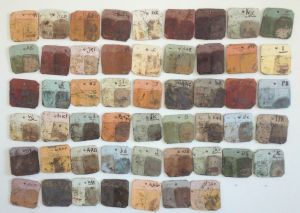 glaze chemistry class with Pete Pinnell. I did a lot of testing of sigs and glazes and tried to come up with a surface that would have the same richness and depth as layers of old weathered paint.
glaze chemistry class with Pete Pinnell. I did a lot of testing of sigs and glazes and tried to come up with a surface that would have the same richness and depth as layers of old weathered paint.
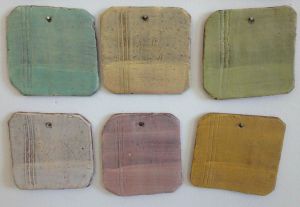 For my functional pots, I primarily use a white crackle slip and a pastel glaze that I developed in that class. I often use colored sigs with patinas and oxide washes on the more sculptural pieces (or the exteriors of functional pieces such as boxes).
For my functional pots, I primarily use a white crackle slip and a pastel glaze that I developed in that class. I often use colored sigs with patinas and oxide washes on the more sculptural pieces (or the exteriors of functional pieces such as boxes).
Do you have a favorite form to make? If so, why? I seem to make quite a lot of bowls and shallow dishes. As someone who loves to cook, I suppose that I like the options that these pots present for serving different types of food.
Do you have a favorite studio tool that you just can’t live without? 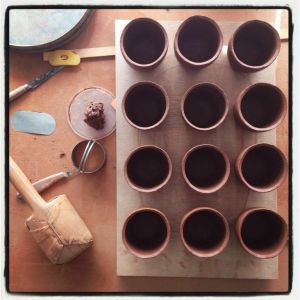 I am sort of a hoarder when it comes to tools (as the two huge drawers full of them in my studio would attest to). But, I regularly use only a handful of basic commercially made tools when I am hand-building my work.
I am sort of a hoarder when it comes to tools (as the two huge drawers full of them in my studio would attest to). But, I regularly use only a handful of basic commercially made tools when I am hand-building my work.
The one tool that I make myself is a wooden mallet that I use to pound out my slabs. I cover the surface of the mallet with canvas so it is less likely to stick to the wet clay.
Aside from an active career as a potter, you also teach full time and have since 2007. I have rarely seen someone balance both as well as you. What’s your secret(s)? I wish I knew what the secret was to finding that balance! After my time at the Bray, I was lucky to get my first teaching position alongside John Balistreri at Bowling Green State University. After four productive years there, I secured a tenure track job at the University of Missouri. Academia is challenging because it puts a high value on what you do in the classroom as well as your creative research.
Although I typically teach only two days per week, there’s always something more that needs doing on my school to-do list, from repairing studio equipment, to ordering supplies or serving on departmental committees. Also, the fact that I have my working studio at school right off the classroom makes it challenging at times to switch gears between my roles as teacher and artist. But, I enjoy working along side my students and I think it helps them to see firsthand how much effort it takes to be a working artist.
So, I have learned to be flexible and try to creatively fit in my making around the demands of the classroom. My workflow can fluctuate widely from week to week during the academic school year, but summer vacation offers the space and uninterrupted time to work on either larger sculptural pieces or to make a large batch of pots. I have learned that it is important for my own mental health that I make it a point to get some making time in on a regular basis.
You’ve spent time at residency programs across the country, most recently in Roswell, New Mexico. Can you talk about what your time as an artist-in- residence has meant for you and your work? In 2006-2007, I was a year-long resident at the Bray right after finishing up graduate school. That year was very formative time for me; the residency gave me the time and support to focus on producing a solid body of work. I also was able to put in a lot of time trying to get my work out into the world to make connections with galleries.
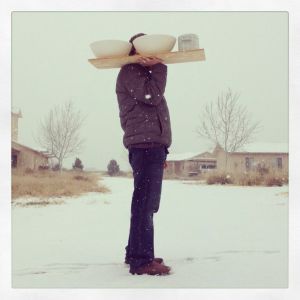 Last year, I was lucky enough to able to do a year-long residency at the Roswell Artist-in-Residence program. After six years of teaching full-time, the gift of the uninterrupted time to be able to devote myself completely to my work was a true blessing. I am very grateful for this opportunity and to the University of Missouri for supporting my research leave.
Last year, I was lucky enough to able to do a year-long residency at the Roswell Artist-in-Residence program. After six years of teaching full-time, the gift of the uninterrupted time to be able to devote myself completely to my work was a true blessing. I am very grateful for this opportunity and to the University of Missouri for supporting my research leave.

Kristen Martincic, double ladder pool, three-plate etching w/ aquatint on mitsumata, 14.75×18.5″, 2012
Your partner is also an exceptionally talented artist (probably best known as a printmaker?). You two have collaborated on work in the past. I am curious how you two feed off each other’s creative processes? I was lucky enough to meet my wife Kristen Martincic while in grad school. I am grateful to have a partner who understands and supports the challenges of being an artist. We both put in long hours in the studio and often help each other troubleshoot problems. Kristen has a solid background in ceramics and we have collaborated on several ceramic pieces in the past. We are planning on a body of work that combines her interest in swimming pools with my focus on vessels for an upcoming two-person show at Turman Larison Contemporary in early 2016. Here’s a link to find out more about Kristen and her work : www.kmartincic.com
You recently redesigned your website. Can you talk about what prompted the change and why you selected the hosting site you did? Can you offer any advice to someone wanting to build/design their own website? About a year ago, I moved my site to a customizable website template through Virb.com. Their designs are simple, clean and easy to navigate. I had recently started having my work photographed on a white backdrop and that prompted me to redesign the layout of my website.
When it comes to building your own site, I would say it is important to look at a lot of artist sites to get an idea of what you like and what you don’t like. There is no right or wrong but it is important that you have a clear idea about how you want to present yourself and do so in the most professional way possible. Be sure to get some constructive feedback from people you trust before your site goes live.
Which marketing venue(s) (website/blog/galleries/studio sales/etsy/craft fairs/etc.) have you found to be the most lucrative for your work?
What kind of advice could you give someone wanting to market their work? Since quite a bit of my time is taken up by teaching, I am 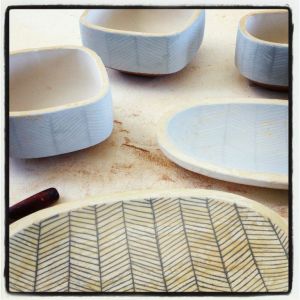 happy to let the galleries I work with take care of the marketing. I have my work in about a dozen retail galleries around the country. Sales can vary a lot from place to place but there are several galleries that have really supported me and my work over the years: Schaller Gallery (St. Joseph, MI), Turman Larison Contemporary (Helena, MT), The Museum of Contemporary Craft (Portland, OR), and Penland Gallery (Penland, NC)
happy to let the galleries I work with take care of the marketing. I have my work in about a dozen retail galleries around the country. Sales can vary a lot from place to place but there are several galleries that have really supported me and my work over the years: Schaller Gallery (St. Joseph, MI), Turman Larison Contemporary (Helena, MT), The Museum of Contemporary Craft (Portland, OR), and Penland Gallery (Penland, NC)
Learning how to market your work takes time and often involves learning some tough lessons through trial and error. First, you have to decide what road (or roads) you want to go down. While some artists choose to focus their efforts on establishing a local clientele, others choose to do the craft fair circuit, while others choose to have galleries deal with the sales (and many artists do a combination all of the above). Each route has its advantages and disadvantages, but I believe it is important to get your work out there and striving to take advantages of all the opportunities at hand.
If you go the gallery route, I would say that getting your actual work in front of a gallery owner really helps. So, when I was starting out, I applied to lots of juried shows. Several of the galleries I am working with now started off with my having one piece accepted into a juried show at their space.
The other way I have gotten into galleries is by researching which ones I think my work would fit into best and whether they carried other artists who’s work I admired. Although the “cold call” technique doesn’t always pan out, it can’t hurt to try if you present yourself in a professional manner.
Finally, what advice can you give aspiring potters trying to make a living? Working as a potter can take its toll on your body, so it is important to take care of yourself (a lesson that has become more and more apparent to me as I get older). For me, this means taking the time to eat well, getting enough rest, and finding time to fit in exercise.
I think that anyone making a living in the arts has a tough row to hoe ahead of them. But with hard work, dedication and some tenacity, you can find (or create) a way to make it. As John Cage said:
“The only rule is work. If you work, it will lead to something. It’s the people who do all the work all the time who eventually catch on to things.”
For more info about Joe and his work, please visit his website: iconceramics.com


